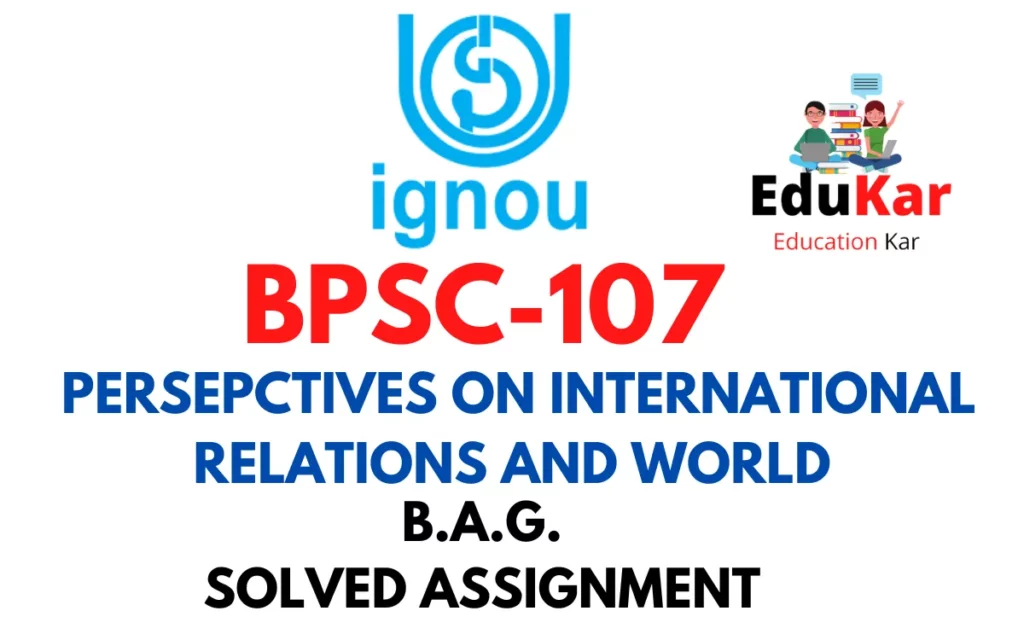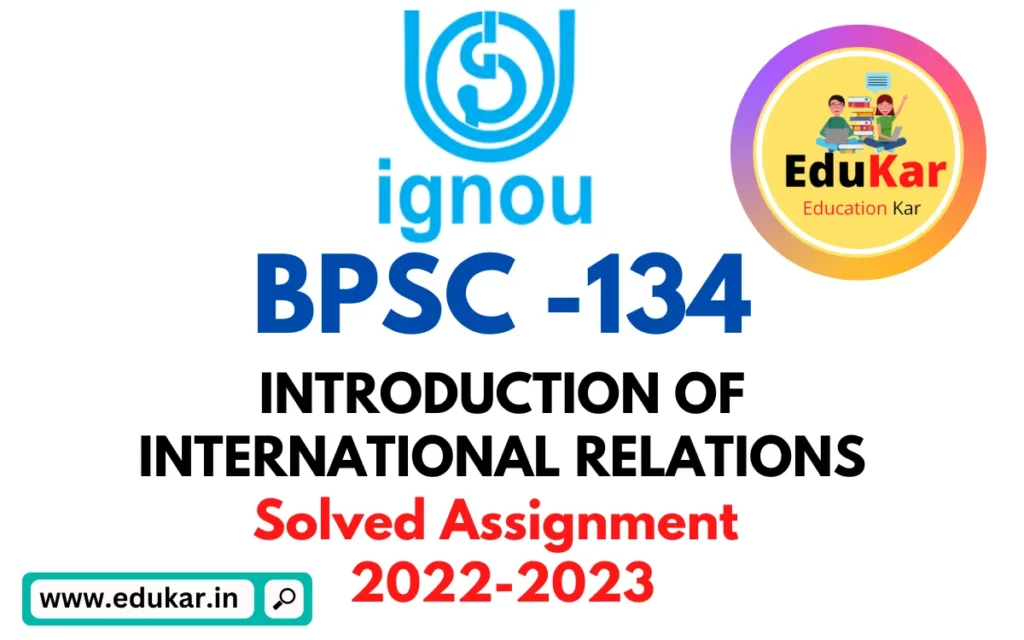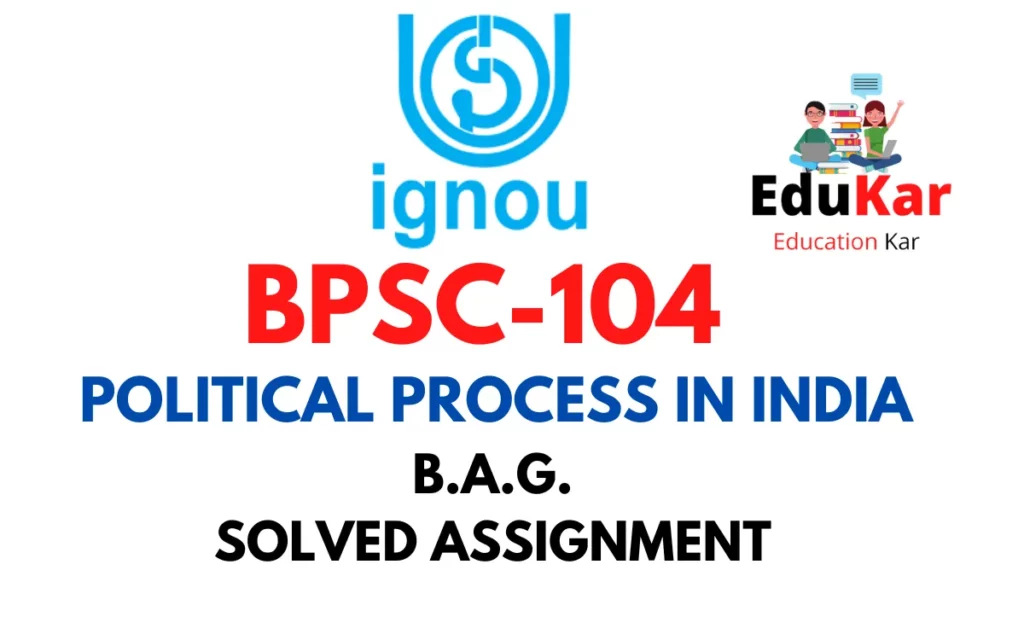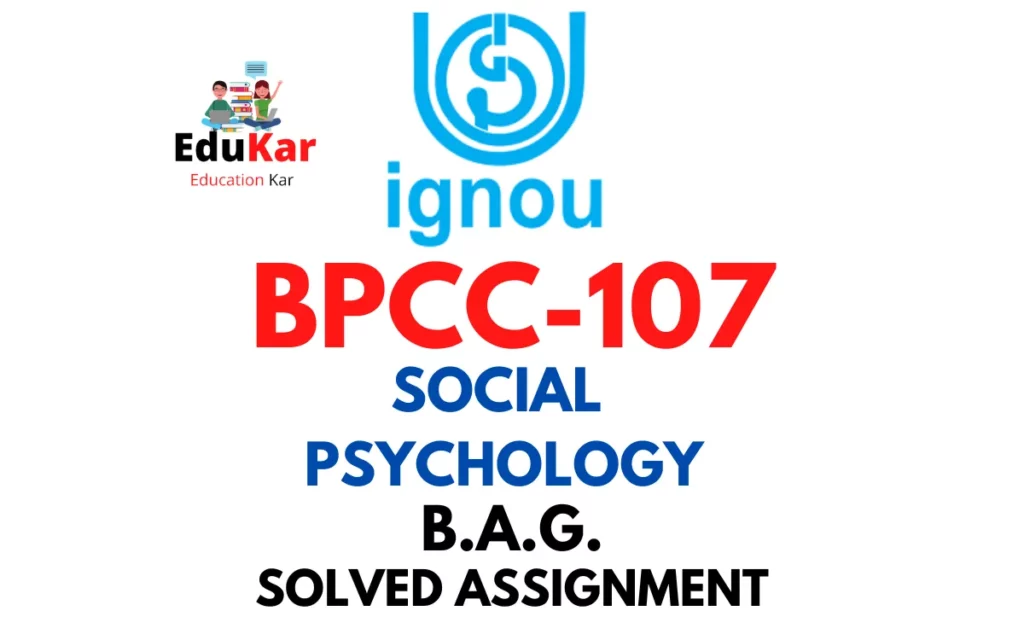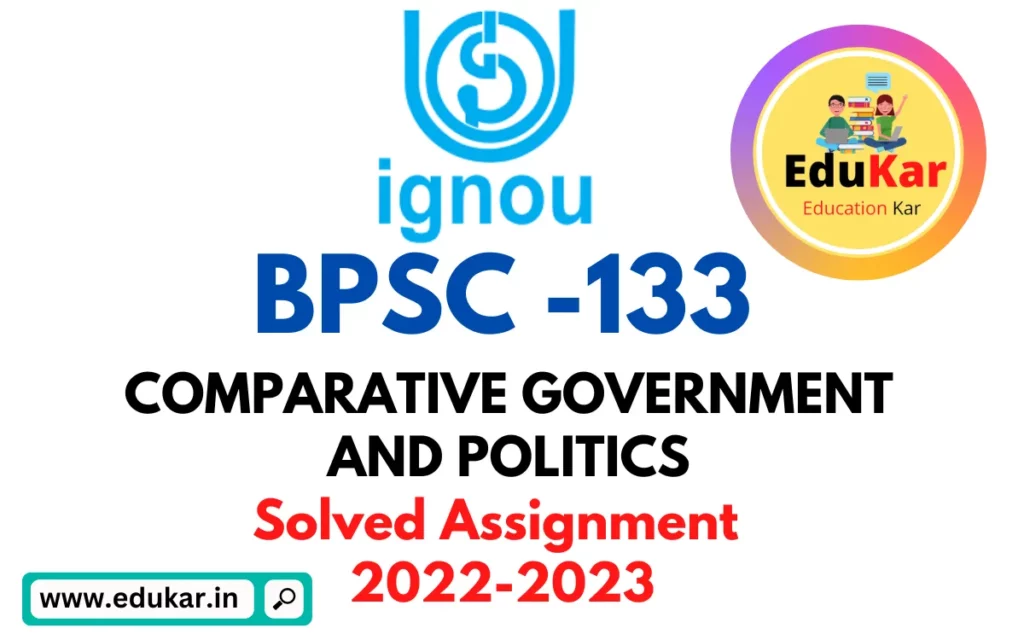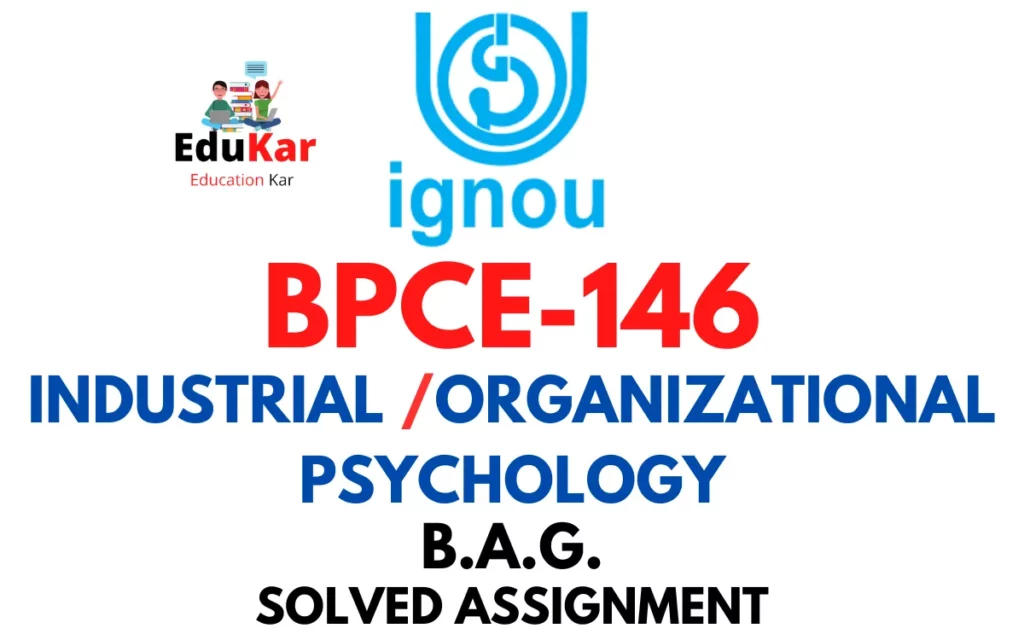Contents
- 1 Assignment – I
- 2 Answer the following in about 500 words each.
- 3 1. Examine different sources of conflict. What are the variants of threats in international conflicts? Discuss.
- 4 2. Explain different theoretical approaches of conflict. Discuss also the ‘nature versus nature’ debate.
- 5 Assignment – II
- 6 Answer the following questions in about 250 words each.
- 7 1. What is the nature of major conflicts in South Asia?
- 8 2. Criticism of Biological and Socio –Biological Theories.
- 9 3. Explain life cycles of conflict.
- 10 Assignment – III
- 11 Answer the following questions in about 100 words each.
- 12 1. Difference between conflict prevention and conflict management.
- 13 2. Resource Theory.
- 14 3. Relative Deprivation Theory.
- 15 4. Examine the objectives and purposes of conflict.
- 16 5. Why is Pacifism important for conflict resolution?
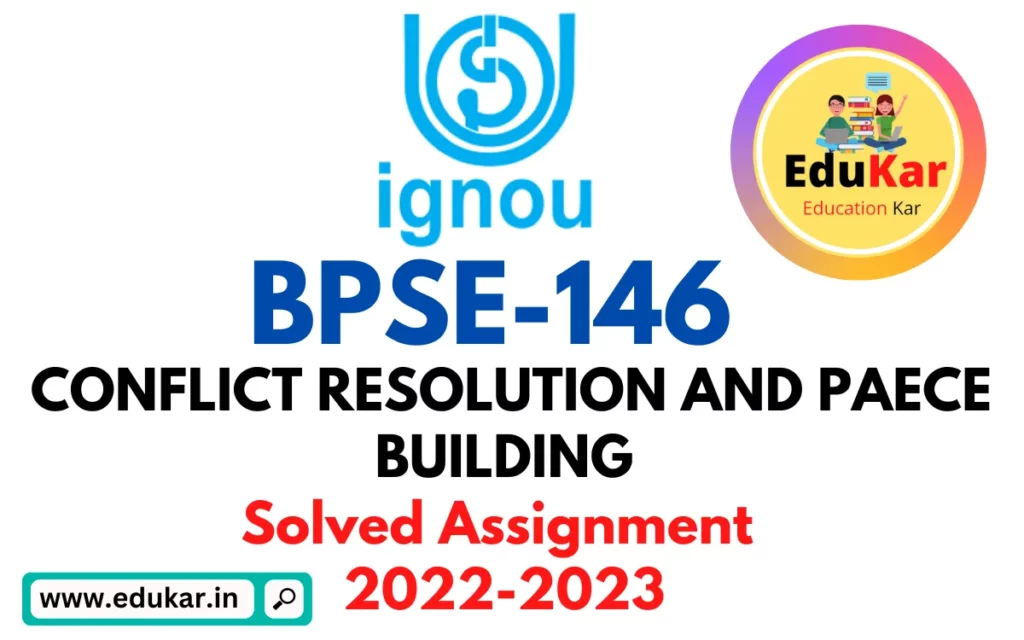
| Title | BPSE-146: IGNOU BAG Solved Assignment 2022-2023 |
| University | IGNOU |
| Degree | Bachelor Degree Programme |
| Course Code | BPSE-146 |
| Course Name | CONFLICT RESOLUTION AND PAECE BUILDING |
| Programme Name | Bachelor of Arts (General) |
| Programme Code | BAG |
| Total Marks | 100 |
| Year | 2022-2023 |
| Language | English |
| Assignment Code | BPSE-146/ASST/TMA/2022-23 |
| Last Date for Submission of Assignment: | For June Examination: 31st April For December Examination: 30th September |
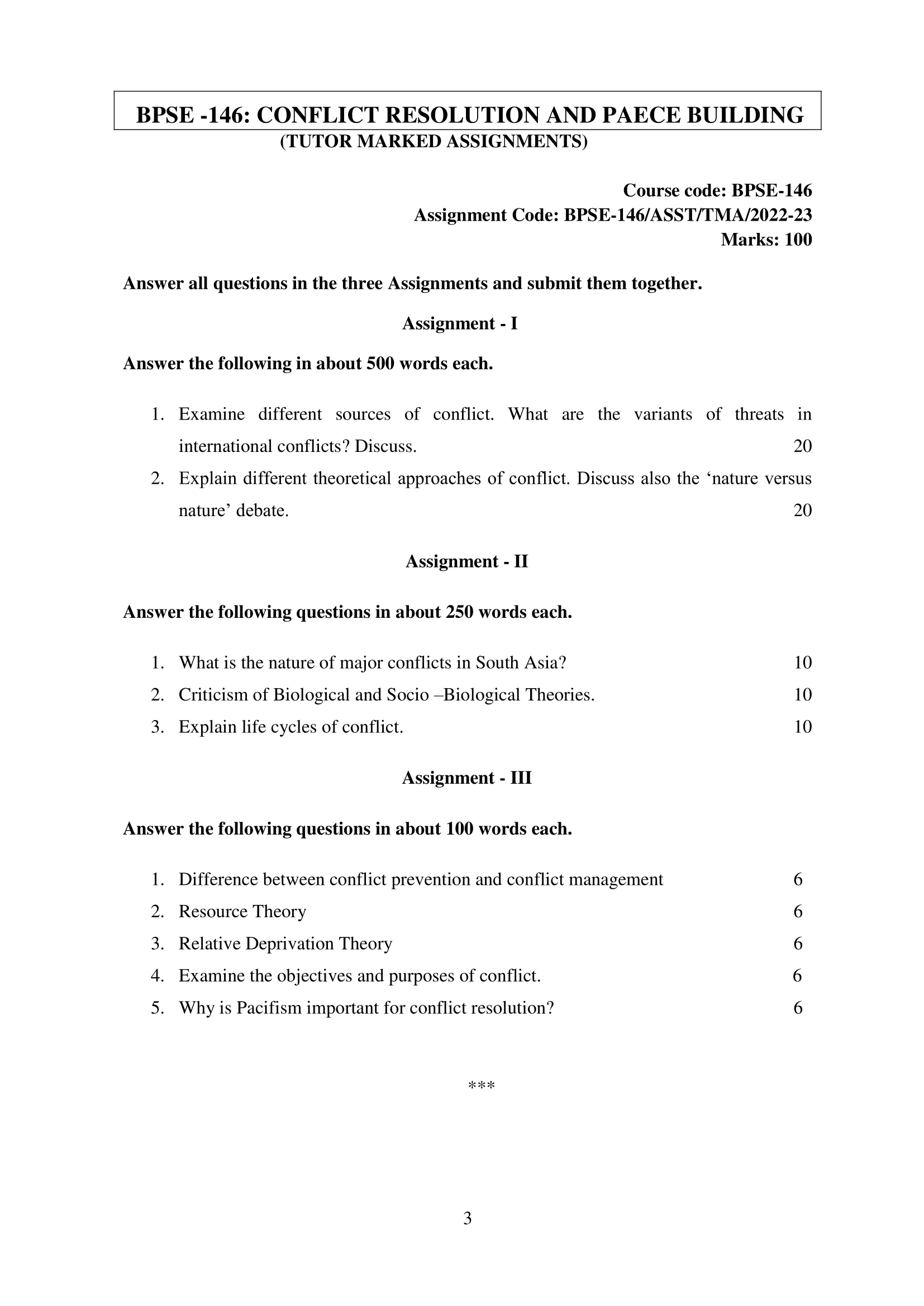
Assignment – I
Answer the following in about 500 words each.
1. Examine different sources of conflict. What are the variants of threats in international conflicts? Discuss.
Ans: Conflict refers to a situation in which two or more parties are in disagreement over their interests, beliefs, values, or needs. Conflicts can take various forms and can arise from various sources. Here are some common sources of conflict:
- Resource competition: This is a conflict that arises when two or more parties compete for scarce resources such as land, water, minerals, or oil. This type of conflict can lead to economic, political, and military tensions between nations.
- Ideological differences: Conflicts can arise when two or more parties have opposing political ideologies, religious beliefs, or cultural values. Ideological differences can lead to the formation of opposing political factions or terrorist groups.
- Historical grudges: Conflicts can arise from historical grudges between two or more nations. These grudges may stem from past wars, territorial disputes, or other historical events that have left a lasting impact on the relationship between the nations involved.
- Territorial disputes: Conflicts can arise from disputes over territory, such as disputes over borders, maritime boundaries, or sovereignty over certain territories.
- Power struggles: Conflicts can arise when two or more parties compete for power and control over resources, territories, or political systems.
There are different variants of threats in international conflicts, including:
- Military threats: This is the use of military force or the threat of military force to achieve a political objective. Military threats can take various forms, including direct military action, military build-up, and mobilization of military forces.
- Economic threats: This involves the use of economic measures to achieve a political objective. Examples of economic threats include sanctions, embargoes, and trade restrictions.
- Political threats: This involves the use of political measures to achieve a political objective. Examples of political threats include diplomatic pressure, political lobbying, and the use of international organizations.
- Cyber threats: This involves the use of cyber attacks to achieve a political objective. Cyber threats can take various forms, including hacking, cyber espionage, and cyber warfare.
- Environmental threats: This involves the use of environmental issues to achieve a political objective. Examples of environmental threats include the use of climate change as a political weapon, the use of environmental degradation as a weapon of war, and the use of natural resources as a means of political leverage.
2. Explain different theoretical approaches of conflict. Discuss also the ‘nature versus nature’ debate.
Ans: Conflict has been studied by various disciplines and theories have been developed to understand its causes, processes, and outcomes. Here are some of the most prominent theoretical approaches to conflict:
- Realism: Realism is a political theory that views conflict as an inevitable part of the international system. Realists argue that states are motivated by self-interest and power, and that they compete for resources and influence in an anarchic international system.
- Liberalism: Liberalism is a political theory that views conflict as the result of a lack of cooperation and integration between states. Liberals argue that conflicts can be prevented or resolved through international institutions, free trade, and mutual cooperation.
- Constructivism: Constructivism is a social theory that argues that conflict is not a result of objective realities, but rather is constructed through the perceptions and ideas of individuals and groups. Constructivists argue that conflict can be prevented or resolved through the creation of new norms and identities.
- Marxism: Marxism is a social and economic theory that views conflict as a result of class struggles between the ruling class and the working class. Marxists argue that conflicts can only be resolved through the establishment of a socialist society.
The nature versus nurture debate in conflict refers to the question of whether conflict is a result of innate human nature or is learned through socialization and experience. The nature argument holds that conflict is a result of innate human tendencies towards aggression and competition. The nurture argument holds that conflict is learned through experience and socialization, and that it is a product of social, economic, and political factors.
While both nature and nurture perspectives have their strengths and weaknesses, many scholars argue that the truth likely lies somewhere in between, and that both nature and nurture contribute to conflict. Some argue that while human nature may incline individuals towards conflict, the specific forms and outcomes of conflict are shaped by cultural, social, and economic factors.
Assignment – II
Answer the following questions in about 250 words each.
1. What is the nature of major conflicts in South Asia?
Ans: The nature of major conflicts in South Asia is primarily political, territorial, and religious. Some of the key conflicts in the region include:
- India-Pakistan conflict: This is one of the longest-standing and most intense conflicts in South Asia. It primarily involves the territorial dispute over the Kashmir region, which has been divided between India and Pakistan since 1947. The conflict has resulted in several wars and numerous skirmishes, and has been a major source of tension between the two countries.
- Sri Lanka civil war: This was a 26-year conflict between the government of Sri Lanka and the separatist group, the Liberation Tigers of Tamil Eelam (LTTE). The conflict was driven by the Tamil minority’s demand for a separate state in the north and east of the country. The conflict ended in 2009, with the defeat of the LTTE, but tensions and discrimination against the Tamil minority remain.
- Bangladesh-Myanmar Rohingya conflict: This is a humanitarian crisis involving the Rohingya Muslim minority in Myanmar. The Rohingya face persecution and discrimination, and many have fled to neighboring Bangladesh as refugees. The conflict has sparked international attention and criticism, and the situation remains unresolved.
- India-Nepal border dispute: This is a territorial dispute between India and Nepal over the Kalapani region in the Himalayas. The dispute dates back to the colonial period and has been exacerbated by conflicting interpretations of historical treaties and maps. The dispute has led to diplomatic tensions between the two countries and has not yet been resolved.
2. Criticism of Biological and Socio –Biological Theories.
Ans: Biological and socio-biological theories have faced criticism from various quarters for various reasons. Here are some of the key criticisms of these theories:
- Determinism: One of the main criticisms of biological theories of conflict is that they are deterministic, meaning that they suggest that conflict is predetermined by genetic or biological factors, and that human agency and choice play a minimal role. This view has been criticized for being reductionist and for ignoring the social, cultural, and political factors that shape conflict.
- Lack of empirical evidence: Another criticism of biological theories is that they lack empirical evidence to support their claims. While there have been some studies that have found correlations between biology and conflict, these studies are often small-scale and have not been able to establish clear causal relationships.
- Ethical and moral objections: Some critics have raised ethical and moral objections to biological theories, arguing that they are inherently racist and that they legitimize violence and conflict. This criticism stems from the fact that some biological theories suggest that some groups or races are inherently more violent or aggressive than others, which is seen as a baseless and harmful claim.
- Overgeneralization: Critics argue that biological and socio-biological theories overgeneralize and oversimplify the complex and multi-faceted nature of conflict. These theories often ignore the role of culture, history, and politics in shaping conflict, and they risk reducing the diversity of human experiences to a single, deterministic explanation.
3. Explain life cycles of conflict.
Ans: The life cycle of conflict refers to the various stages that a conflict goes through, from its inception to its resolution or escalation. While the exact stages in a conflict’s life cycle may vary, the following is a general outline of the key stages:
- Emergence: The first stage in the life cycle of conflict is the emergence stage, in which the roots of the conflict become apparent. This stage may involve rising tensions between conflicting parties, and the gradual build-up of differences that eventually lead to open conflict.
- Escalation: The second stage is the escalation stage, in which the conflict begins to intensify. At this stage, the parties involved may engage in more direct and hostile actions towards each other, such as aggressive rhetoric, physical violence, or military action.
- Crisis: The third stage is the crisis stage, in which the conflict reaches its peak. At this stage, the conflict is at its most intense, and the parties involved may be engaged in open warfare or intense negotiations.
- Stabilization: The fourth stage is the stabilization stage, in which the conflict begins to subside. This stage may involve a ceasefire, a peace agreement, or a negotiated settlement, and it marks the beginning of a transition towards a more peaceful resolution of the conflict.
- Resolution: The fifth and final stage is the resolution stage, in which the conflict is fully resolved. This stage may involve the implementation of a peace agreement or the reintegration of opposing parties into a peaceful and cooperative relationship.
It is important to note that not all conflicts follow a linear life cycle, and that some conflicts may escalate to the point of total war or result in a prolonged state of instability. Additionally, some conflicts may also experience cycles of escalation and de-escalation, with periods of stability and peace alternating with periods of crisis and escalation.
Assignment – III
Answer the following questions in about 100 words each.
1. Difference between conflict prevention and conflict management.
Ans: Conflict prevention refers to measures taken to stop a conflict from arising or escalating, such as diplomatic negotiations, peacekeeping missions, or institution-building efforts. Conflict management, on the other hand, refers to strategies used to mitigate the negative effects of an ongoing conflict, such as mediating a peaceful resolution, implementing ceasefires, or providing humanitarian aid. The goal of conflict prevention is to avoid violence and instability, while the goal of conflict management is to reduce harm and restore stability to a conflict-affected area.
2. Resource Theory.
Ans: Resource theory is a concept in international relations that seeks to explain the causes of conflict and cooperation between states. It holds that the competition for limited resources, such as territory, water, minerals, and energy, is a primary driver of conflict between states. According to resource theory, states may use military force or engage in other forms of aggressive behavior to secure resources they perceive as essential to their survival or prosperity. At the same time, cooperation and collaboration can also occur when states recognize the benefits of pooling their resources or sharing access to them. Resource theory thus provides a framework for understanding how the distribution of resources affects state behavior in the international system.
3. Relative Deprivation Theory.
Ans: Relative deprivation theory is a social-psychological theory that explains the causes of social protest and unrest. It suggests that individuals or groups become discontent and motivated to take action when they perceive that they are unfairly deprived of resources or opportunities compared to others in their reference group. This perception of relative deprivation can stem from real or perceived differences in income, education, social status, or access to political power. The theory argues that when individuals or groups feel that they are being unfairly treated, they may become frustrated and seek to challenge the existing social, political, or economic system. This can lead to acts of collective protest or violence, as individuals or groups seek to rectify the perceived injustices they face.
4. Examine the objectives and purposes of conflict.
Ans: The objectives and purposes of conflict can vary widely, depending on the actors involved, the context, and the type of conflict. However, some common objectives and purposes of conflict include:
- Gain or defend territory, resources, or political power: Conflicts may arise when actors seek to expand their control over territory, resources, or political power, either through military means or through diplomatic or economic pressure.
- Pursue political, social, or economic goals: Conflicts may also be driven by actors seeking to advance particular political, social, or economic ideologies, such as nationalism, religious fundamentalism, or capitalism.
- Protect or promote personal or group interests: Conflicts may also stem from individuals or groups seeking to protect or promote their own interests, such as their security, economic well-being, or cultural identity.
- Resolve or address grievances: Conflicts can also arise as a means of resolving disputes or addressing grievances, such as unequal distribution of resources or perceived injustices.
Ultimately, the objectives and purposes of conflict are diverse and complex, and can be shaped by a range of individual, group, and systemic factors.
5. Why is Pacifism important for conflict resolution?
Ans: Pacifism is a philosophy that emphasizes the use of non-violent means to resolve conflicts and promote peace. It is based on the belief that violence only begets more violence, and that peaceful and cooperative approaches are more likely to lead to lasting solutions.
Pacifism is important for conflict resolution because it provides an alternative to war and violence, and encourages the use of diplomacy, dialogue, and negotiation to resolve disputes. Pacifist approaches can help to de-escalate tensions and reduce the likelihood of violence, while also promoting mutual understanding, respect, and cooperation.
Pacifism can also play a role in promoting long-term peace and stability, by encouraging the resolution of conflicts in ways that address the underlying causes, rather than simply suppressing the symptoms. By prioritizing peaceful approaches to conflict resolution, pacifism can help to build trust and foster a culture of peace, which can in turn reduce the likelihood of future conflicts.
Therefore, pacifism is an important aspect of conflict resolution as it emphasizes the importance of non-violent methods and promotes peaceful approaches to resolving conflicts, which can lead to more sustainable and equitable outcomes.
How to Download BPSE-146 Solved Assignment?
You can download it from the www.edukar.in, they have a big database for all the IGNOU solved assignments.
Is the BPSE-146 Assignment Free?
Yes this is absolutely free to download the solved assignment from www.edukar.in
What is the last submission date for BPSE-146 Assignment?
For June Examination: 31st April, For December Examination: 30th October

